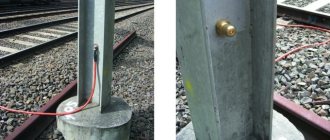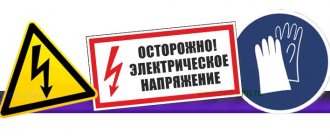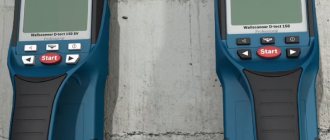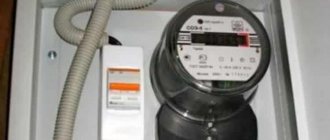Due to the high degree of danger, working with electrical installations requires special qualifications. Since any electrical installations are objects of increased risk to health and life, everything related to working with them is clearly regulated and established in special rules, regulations and acts. Specialists who carry out work at such facilities are issued a special document called a work permit for work in electrical installations .
- Form and sample
- Online viewing
- Free download
- Safely
FILES
What is POTEU
Rules for labor protection during the operation of electrical installations are a regulatory document containing state standards for labor protection and safety when carrying out work in electrical installations (in relation to Article 209 of the Labor Code of the Russian Federation).
For your information! Along with it, another important document is used in the work of electrical facilities - the Rules for the Technical Operation of Consumer Electrical Installations (PTEEP), approved. by order of the Ministry of Energy of the Russian Federation dated January 13, 2003 No. 6 (last edition dated September 13, 2018). They apply to organizations, individual entrepreneurs, and citizens and are designed to ensure rational operation and proper maintenance of electrical installations.
The requirements of POTEU apply to all employers, since they are the ones who are obliged to create safe working conditions for workers. These are generally established requirements, which employers have the right to supplement depending on the specifics of the activity being carried out.
Read about the development, structure, and purpose of the Regulations on the Labor Protection Management System in our material .
Employees who work in enterprises that use (serve) electrical installations are required to know and apply POTEU. Before starting work on an electrical installation, each of them goes through:
- Special training, including how to provide first aid to an injured person.
- Testing the acquired knowledge on POTEU.
Those who successfully complete their studies and testing are issued a certificate with appropriate marks of access to special work. According to POTEU, workers are assigned one of five electrical safety groups.
ConsultantPlus experts explained in detail how to conduct electrical safety training for electrical personnel. To do everything correctly, get trial access to the system and move on to the final solution. It's free.
What is a permit for electrical installations?
Working with live installations is subject to legislative regulation of safety standards and regulations. Such rules are necessary to preserve the life and health of citizens, as well as to prevent equipment failure. In addition, training events are carried out with staff on an ongoing basis, which end with a safety knowledge test.
A typical sample of an approval order for work in installations
An electrical installation is a source of increased danger, posing a threat to the life and health of not only the personnel directly working with it, but also for other workers in the immediate vicinity. That is why labor legislation requires strict compliance with all norms and requirements for the protection and distribution of responsibility between individual specialists and the manager as a whole.
Form of a standard journal for recording permit orders at an enterprise
If they successfully pass the certification, workers are allowed to carry out repair, preventative and other work on live installations. However, the specifics of working with electricity require special consideration for the implementation of these works, which is expressed in the presence of a special document - a work permit for work in electrical installations. This document is an act of strict internal reporting, developed and published by the responsible occupational safety specialist and is subject to permanent recording and storage.
Important! Electrical safety requires strict consideration of all ongoing activities and a clear division of responsibility, both for the overall progress of work and for individual operations.
A permit for work in electrical installations is a mandatory attribute for carrying out hazardous and harmful work associated with exposure to electric current. As a rule, in the event of an emergency situation and subsequent investigation, it is this document that will serve as the basis for bringing the officials responsible for carrying out the work to various measures of responsibility. This document must indicate the initials of both the workers directly carrying out certain actions and the responsible engineering personnel of the enterprise who conduct electrical installation instructions, issue tasks and directly monitor the execution of the list of instructions during the work.
Personnel are also required to familiarize themselves with the contents of the permit, since each copy of the act is issued to all parties to the activity, and a note about its publication is entered in a special accounting journal and the number of such acts is determined. Federal and industry legislation has not approved a specific form or sample of such an act, so an enterprise can develop its own type of document, however, the legislator provides a list of information that is entered into the document on a mandatory basis. By issuing this local regulatory act in a certain form, the employer or his representative confirms the qualifications of individual employees and allows them to carry out the specified type of work with electrical installations.
Important! When carrying out work with electricity, the issuance of such a document is mandatory. In its absence, the responsible specialists will bear administrative responsibility when conducting an inspection by government agencies.
Carrying out repair activities on installations that require special permission
POTEU from 2022
The new Rules on labor protection during the operation of electrical installations - 2022 replaced the old ones, once approved by order of the Ministry of Labor dated July 24, 2013 No. 328n.
Note! Since 2001 and for 13 years, intersectoral OSH Rules have been applied in practice (introduced by Resolution of the Ministry of Labor No. 3). Over time, they were replaced by POTEU, introduced by Order No. 328n (now they are no longer used).
The POTEU in force from 2022 (see order No. 903n) are designed for five years and are subject to mandatory execution. They are more meaningful because they have been supplemented taking into account all the progressive processes that have occurred over 7 years (the period of validity of the previous rules). That is, they take into account the spread of remote control (RC) of electrical installations, the emergence of new safety measures when carrying out special work, etc.
New POTEU are not applied to specialized installations. Requirements for the latter are determined by industry OSH Rules and are reflected in the relevant regulatory documents for their maintenance. It should be noted that starting from 2022, new safety requirements have been introduced for a period of five years for various works.
A list of them and accompanying recommendations from the Ministry of Labor of the Russian Federation can be found in the material “Employers must organize the next test of occupational safety knowledge .
Sample work permit for work in electrical installations
State legislation in the field of labor protection does not establish a strict framework for the production and approval of a standard form for such an access order. Accordingly, enterprises themselves can develop a special form that will take into account the rules for maintaining their own document flow, as well as the specifics of its activities. However, the document must comply with legal requirements and must contain:
- The name of the organization and the obligatory stamp in place of the date of publication of the relevant document;
- Order of the enterprise, its number and date, on the basis of which the standard document was developed;
- Signature of the manager or responsible specialist responsible for issuing the act;
- Initials and positions of employees involved in the work;
- The start and end time of current work with the obligatory indication of the hourly interval, as well as the telephone number of the responsible services;
- Initials of the head of the staff unit monitoring ongoing preventive, repair or other measures;
- Mandatory indication of the type of work and its nature, indicating the name of the equipment and its voltage;
- Indication of targeted training on knowledge of technical standards and safety rules when working with electric current;
- Signatures of employees who were instructed and who will carry out direct work activities.
Note! Organizations can also independently enter additional information about the object of work, the specifics of such actions, as well as the use of special protective equipment if necessary.
An example of a fully completed permit for work in live installations
As a result, the permit for work in electrical installations is a mandatory internal document that authorizes a certain circle of employees to carry out such work. In its absence, officials in the event of an abnormal or emergency situation are subject to varying levels of responsibility from regulatory government agencies.
POTEU-2021 for employers
The updated edition of the Labor Safety Rules when working in electrical installations defines the minimum safety requirements that are mandatory for use. Taking them into account, the employer must adequately approach the assessment of all risks within the framework of the activities carried out and, based on this, organize labor protection.
Important! According to the 2021 Rules, all organizations (employers) whose work is related to electrical installations (electrical safety) must conduct an unscheduled knowledge test regarding occupational safety requirements. According to Decree of the Government of the Russian Federation No. 1580 dated 10/01/2020, the period for this inspection for heat supply facilities has been extended until 07/01/2021. Taking into account the listed standards, employers independently set a time for employee certification.
POTEU-2021 oblige employers to provide occupational safety and bear responsibility for this without the right to transfer it to other persons from among the management team.
The employer has the right:
- Exercise control over production safety by remote audio, video and other recording of what is happening during work.
- Use the recommended form for the permit, certificate and other applicable forms, or develop your own version of the document based on them.
- Maintain OT document flow in electronic form using an electronic signature.
All requirements regarding occupational safety are included in the instructions for labor protection during the operation of electrical installations. They are communicated to employees in the form of instructions and instructions.
Attention! For violation of the requirements of POTEU (admission to work without training, knowledge testing), penalties are provided under Art. 5.27.1. Code of Administrative Offenses of the Russian Federation up to 80 thousand rubles. for legal entities. In case of repeated similar violations, in addition to imposing a fine, the activities of the individual entrepreneur or organization may be suspended for 90 days.
Admission to work and performance of high-risk work according to work permits
Before allowing team members to perform high-risk work, the responsible foreman, together with the person admitting them, must check the implementation of measures to prepare the work site.
All performers must undergo targeted training before starting work. Without targeted instruction, permission to work is not permitted.
After checking the implementation of the activities and conducting instructions, permission to carry out the work must be formalized in the work permit signed by the responsible manufacturer of the work.
If, when checking the implementation of activities, the permitting authority or the responsible work manager has doubts about ensuring safe working conditions for team members, they may request clarification from the responsible work manager.
When performing high-risk work, workers must be provided with personal protective equipment in accordance with industry standards and taking into account the dangerous and harmful production factors affecting them.
After the team members are allowed to work, one copy of the work permit must remain with the responsible producer of the work, the second - with the person who issued it.
From the moment the team members are allowed to work, supervision of the safe conduct of work must be carried out by the responsible foreman.
After the end of the working day, workplaces must be put in order, the permit must be handed over to the responsible work manager or the person who issued the permit.
A short list of the main changes to POTEU-2021
- New (clarified) terms: “energy sales organizations”, “permission work order”, “lifting structures”, “insurance system”.
- Mandatory industrial safety certification for persons responsible for safety during the operation of lifting structures.
- Additional procedure for filling out certificates for admission to special work, issued upon employment. Replacement of ID when changing position.
- Maintenance of electrical installations is assigned to a specific category of workers (operational and repair, operational, administrative and technical personnel).
- Strengthening the security of electrical installations: mandatory accounting for the issuance/return of keys to premises and installations for operating personnel. Monitoring the presence of workers on the territory of the relevant facilities.
- Registration of a work permit for a day or work shift to perform live work on conductive parts of electrical installations. Increasing the shelf life of this closed document to one year.
If, for example, a permit was issued for such work for a day, but the work was not completed during the day, then, according to the current Labor Safety Rules in Electrical Installations, a new permit must be issued the next day.
- An expanded list of works for workers in electrical installations with voltages over 1000 V. These include: herbicide treatment, programming, taking readings from an electronic meter using a laptop computer, etc.
- An expanded list of small-scale works that are performed per shift in electrical installations with a voltage of 1000 V: cleaning, snow removal, marking.
- Determination of actions for preparing the workplace that dispatch personnel are allowed to perform when remotely controlling switching devices and grounding legs with automated workplaces.
- Clarification of measures for the safe performance of work under voltage on live parts in electrical installations up to and above 1000 V.
Attention! Work in electrical installations is permitted only with the use of electrical protective equipment that is selected for specific work methods and taking into account the voltage class. POTEU-2021 increases the requirements for PPE and excludes power tools with protection class 0. Therefore, where there is no increased danger, you still need to use hand tools with protection class 1 and higher.
04. Occupational safety during work in existing electrical installations.
Home → Order on approval of labor safety rules during the operation of electrical installations dated July 24, 2013 N328н → 04. Occupational safety during work in existing electrical installations.
4.1. Work in existing electrical installations must be carried out:
- according to the assignment for the production of work, drawn up on a special form of the established form and defining the content, place of work, time of its beginning and end, conditions for safe performance, composition of the team and workers responsible for the safe performance of work (hereinafter referred to as the work permit, work order), form which and instructions for filling it out are provided in Appendix No. 7 to the Rules;
- by order;
- based on the list of works performed in the order of current operation.
4.2. Unauthorized work in existing electrical installations is not allowed, as well as expansion of jobs and the scope of the task determined by the work order, order or list of work approved by the employer, performed in the course of routine operation.
4.3. Carrying out work at the work site under a different order must be agreed upon with the employee who issued the first order (responsible manager or work performer). Approval is issued before the start of preparing the workplace for the second work order with the entry “Approved” on the front side of the second work order, located in the lower left field of the document with the signatures of the workers approving the document.
4.4. Major repairs of electrical equipment with voltages above 1000 V, work on live parts without removing the voltage in electrical installations with voltages above 1000 V, as well as repairs of overhead lines regardless of voltage, must be carried out according to technological maps or a work project (hereinafter referred to as the work plan), approved by the head of the organization. Work on induced voltage lines (disconnected overhead lines, overhead communication lines (hereinafter referred to as VLS), on power transmission lines consisting of overhead and cable sections connected to each other (hereinafter referred to as ACL), which run along the entire length of the line or in certain areas near overhead lines with a voltage of 6 kV and higher or near the contact network of an electrified AC railway that are under operating voltage, on the wires (cables) of which, with different grounding schemes (as well as in the absence of grounding), at the highest operating current of the influencing overhead lines, voltage more than 25 V, as well as all overhead lines built on double-circuit (multi-circuit) supports with at least one circuit with a voltage of 6 kV and higher turned on (hereinafter referred to as overhead lines under induced voltage) are carried out according to the work permit for the work being performed.
4.5. In electrical installations with voltages up to 1000 V, when working under voltage, it is necessary to:
- relieve voltage from other live parts located near the workplace that are energized, which may be accidentally touched, or protect them;
- work in dielectric galoshes or standing on an insulating stand or on a rubber dielectric carpet;
- use an insulated tool (screwdrivers must have an insulated shaft) or use dielectric gloves.
It is not allowed to work in clothes with short or rolled up sleeves, or to use hacksaws, files, or metal meters.
4.6. It is not allowed to work in electrical installations in a bent position if, when straightened, the distance to live parts is less than the distance specified in Table No. 1.
When working near unprotected live parts, it is not allowed to be positioned so that these parts are behind the worker or on both sides of him.
4.7. It is not allowed to touch insulators or insulating parts of live equipment without using electrical protective equipment.
4.8. In crossing spans in outdoor switchgear and on overhead lines, when replacing wires (cables) and related insulators and fittings located below live wires, ropes made of vegetable or synthetic fibers. The ropes should be thrown in two places - on both sides of the intersection, securing their ends to anchors and structures. Lifting the wire (cable) should be done slowly and smoothly.
4.9. Work in the outdoor switchgear on wires (cables) and related insulators, fittings, located above wires, and energized cables must be carried out in accordance with the PPR approved by the head of the organization or separate unit. The PPR must provide measures to prevent the lowering of wires (cables) and to protect against induced voltage. It is not allowed to replace wires (cables) during this work without removing the voltage from the crossed wires.
4.10. Workers should remember that after the voltage at the electrical installation has disappeared, it can be reapplied without warning.
4.11. Work in unlit places is not allowed. The illumination of work areas, workplaces, passages and approaches to them must be uniform, without the glare of lighting devices on workers.
4.12. When a thunderstorm approaches, all work must be stopped on overhead lines, overhead lines, outdoor switchgear, on inputs and switching devices of indoor switchgear directly connected to overhead lines, on lines for transmitting electricity or individual pulses of it, consisting of one or more parallel cables with connecting, stop and end cables. couplings (seals) and fasteners, and for oil-filled cable lines, in addition, with feeders and an oil pressure alarm system (hereinafter referred to as CL) connected to overhead line sections, as well as at overhead line inputs in the premises of communication centers and antenna mast structures .
4.13. Workers working in rooms with electrical equipment (except for control panels, relay rooms and the like), in closed switchgear and open switchgear, in underground structures, wells, tunnels, trenches and pits, as well as those involved in the maintenance and repair of overhead lines, must use protective helmets.
4.14. On overhead lines, regardless of the voltage class, it is allowed to move workers along wires with a cross-section of at least 240 square meters. mm and along cables with a cross-section of at least 70 sq. mm, provided that the wires and cables are in good technical condition and have no damage caused by vibration or corrosion. When moving along split wires and cables, the lanyard of the safety belt should be secured to them, and if a special cart is used, to the cart.
4.15. Maintenance of lighting devices located on the ceiling of machine rooms and workshops from the overhead crane trolley must be carried out by at least two workers, one of whom must have group III and perform the corresponding work. The second worker must be close to the worker and monitor his compliance with the necessary safety measures.
The installation of temporary scaffolding and ladders on an overhead crane trolley is not allowed. Work should be done directly from the trolley deck or from stationary scaffolds installed on the deck.
The trolley wires must be de-energized before being lifted onto the overhead crane trolley. When working, you should follow labor safety rules when working at height.
The crane operator must move the bridge or trolley of the overhead crane only at the command of the work foreman. When moving an overhead crane, workers must be positioned in the overhead crane cabin or on the bridge deck. When workers are on the overhead crane trolley, movement of the bridge and trolley is prohibited.
4.16. When carrying out excavation work, it is necessary to comply with the requirements of building codes and regulations.
Return to Order
Results
Order of the Ministry of Labor of the Russian Federation dated July 24, 2013 No. 328n has become invalid. From 01/01/2021 new Rules on labor protection in electrical installations are in force. They are mandatory for use in enterprises using or servicing electrical installations. Their validity period ends on December 31, 2025.
POTEU-2021 has been supplemented with new provisions and requirements that take into account modern conditions. In connection with their entry into force, it is required:
- Make changes to the safety instructions and training programs in accordance with the innovations.
- Organize training for those responsible for testing knowledge using the new rules.
- Conduct an extraordinary knowledge test taking into account the requirements of Rostechnadzor (letter dated January 26, 2021 No. 00-06-05/55).
You can find more complete information on the topic in ConsultantPlus. Free trial access to the system for 2 days.
How to fill out an admission order
Work permit for work at height
The authorization order is filled out by the responsible labor protection specialist in the company or the head of the department as the stages of its implementation progress. When undergoing targeted training, information about the circle of persons in respect of whom the event was carried out, safety information is entered into the report, and signatures are necessarily collected in the column about its completion. After this, specific information about the work being carried out is entered into the act - preventive measures, repair or planned actions with the equipment.
Note! Such a certificate is issued to both the manager and employees, who, after completing the work, hand over the document to the responsible person for record keeping.
Accounting is carried out through a special journal for recording permit orders. This regulatory document of strict internal reporting is kept only by the manager or occupational safety specialist for 10 years. In its absence, government authorities will impose an administrative fine and an order to eliminate the violation. In case of extension of work, special notes are included in the act for all aspects of the activity, which must be completed by a certain specialist in the event that the operational labor protection officer is not on site. A new certificate is issued if the employee needs to be sent on a business trip; this duty must also be performed by the labor protection worker in the organization.
Carrying out control activities by the responsible specialist at the enterprise to clarify the requirements for admission





